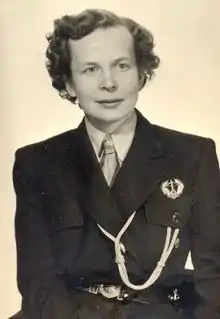Helvi Sipilä
Helvi Linnea Aleksandra Sipilä (née Maukola; 5 May 1915 – 15 May 2009) was a Finnish diplomat, lawyer and politician. She was known as a promoter of women's rights, and was the first-ever female Assistant-Secretary-General of the United Nations. When Sipilä was appointed Assistant-Secretary-General in 1972, 97 per cent of United Nations senior management (D1 and above) was male.[1] Sipilä also held a number of leadership positions in international civic organizations, including in the World Association of Girl Guides and Girl Scouts, the International Federation of Women Lawyers, Zonta International and the International Council of Women.
Helvi Sipilä | |
|---|---|
 Mrs. Sipilä in the 1950s when she acted as a chief of the Finnish girl scouts organization. | |
| Born | 5 May 1915 |
| Died | 15 May 2009 (aged 94) |
| Burial place | Kärkölä, Finland |
| Nationality | Finnish |
Sipilä began her career as a lawyer and opened her own legal office in 1943. As a UN Assistant Secretary-General, she was in charge of the Center for Social Development and Humanitarian Affairs from 1972 to her retirement from the post in 1980. She organized the first World Conference on Women in 1975 and had a great influence on the United Nations' decision to celebrate the Decade for Women and establish the Development Fund for Women (UNIFEM) in 1976.[2]
In 1982, Sipilä became the first woman to run for President of Finland, as a candidate of the Liberal People's Party. She held twelve honorary doctorates and was granted the title of Minister in 2001.[3]
References
- Obituary at UN Women.
- "Helvi Sipilä at 85 – a strong-willed woman marks the way". Helsingin Sanomat. 5 May 2000. Archived from the original on 24 October 2008. Retrieved 16 May 2009.
- "Helvi Sipilä dies". YLE. 16 May 2009. Archived from the original on 29 December 2011. Retrieved 16 May 2009.
Further reading
- Helvi Sipilä Biography at UN Women, 20 May 2009
- Helvi Sipilä Biography at “100 faces of Finland” (in Finnish)
- Helvi Sipilä, “Changing Roles of Women in the Developing Regions of the World.” Journal of International Affairs. Fall 76 / Winter 77, Vol. 30 Issue 2: 183–191.